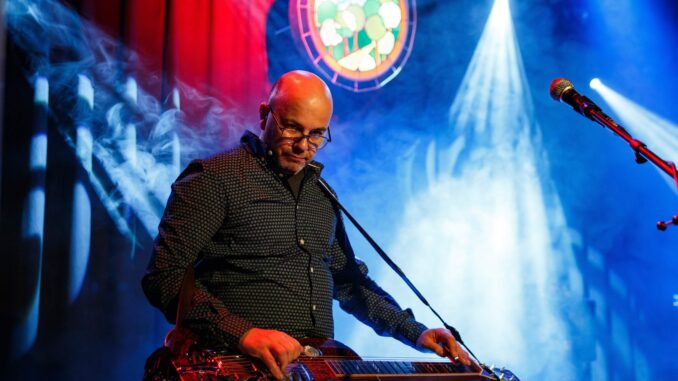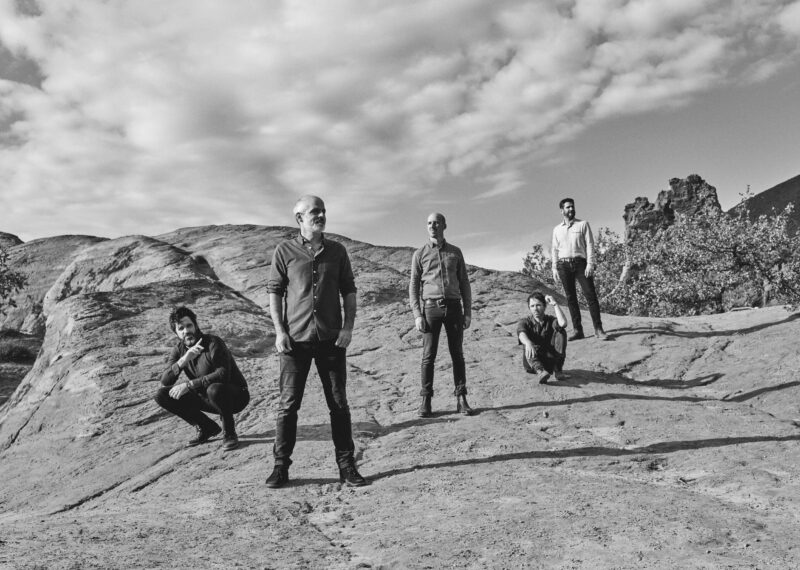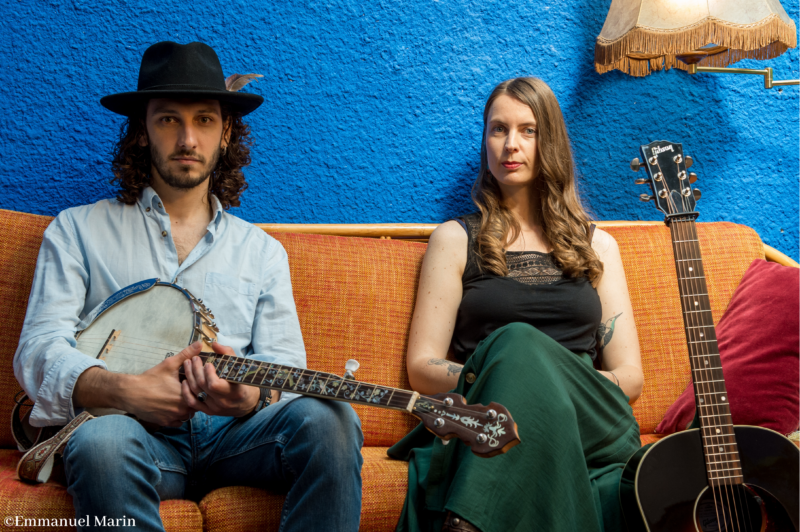
Home territory for me and the enigma that is France.
On paper, France should be a major territory for americana. Americana is often spoken about as being a continuation of the Troubadour tradition and France is where the Troubadour tradition started, in the Occitan region in the 11th century. The Troubadours were travelling musicians who sang love songs and set poetry to music but evolved into spreaders of news and information via their songs, similar to the singer/songwriters of today. Another aspect of French culture that should make it receptive to americana music are the instruments closely associated with the genre. Guitar, banjo, accordion and fiddle are all popular instruments in France and are used extensively in French folk music. Folk and blues, two of the roots music elements that go to make up americana, are very popular here, with many festivals dedicated to both taking place all over the country in the summer months. Even bluegrass is gaining in popularity in France, with Europe’s largest bluegrass festival taking place at La Roche sur Foron, in the French Alps, not far from Geneva. 2025 will see the La Roche Bluegrass Festival celebrate its 20th year. So there are plenty of the elements that make up americana music in play here in France, but the country has yet to embrace it as a genre. Though that may be changing.
The biggest barrier is, of course, language. Americana is an almost exclusively English language genre and, while many French people speak English, it would be fair to say that few do so enthusiastically. It’s not that the French can’t perform in English, but few can do so without a distinctly French accent, and this would seem to be a sticking point for many French musicians.

La Maison Tellier are a superb band who have been favourably compared to Calexico and who consider Neil Young to be one of their greatest musical influences, so much so that, in recent years, they have performed a series of concerts where they play the Harvest album in its entirety, often with other French musicians joining them as guests. I asked them if they marketed themselves as an americana band. “Not really. Perhaps in the beginning, but not anymore, since we’re not good enough to play “real” americana music, or we just don’t want to copy our heroes in a cheap French version. We’re a French band, who sing French songs, in French, above “americana inspired music”. Yet the band readily admit the americana influence on their music, “we use a lot of americana’s clichés in our compositions, like elements of country, folk or blues, especially typical folk instruments like acoustic six and twelve strings guitars, banjo, mandolin, lapsteel, double bass, or standard folk instrumentations/arrangements such as fingerpicking, bluegrass strumming, classic folk chords progressions. Moreover, we often add trumpets and horns in our songs, which gives a very cinematographic dimension, and a special mariachi vibe”.
It seems that what many French musicians operating in this genre are most concerned about is coming across as a cheap copy. Manu Bertrand is the Buddy Miller of French americana. A talented multi-instrumentalist who is in great demand as a session player, he also produces for several up and coming young French musicians as well as being the musical director for Martha Fields’ superb country and americana band (Martha moved to France from Texas and her albums have frequently topped the Eurpean Americana charts. Her band is made up of all French musicians and they could go toe to toe with some of the best players in Nashville). He’s a little more positive about the potential for americana in Europe in general, “Americana here in France is, by nature, different. We have a lot of problems with the accent, that makes it different very fast. We are a little bit better nowadays, I think, it’s coming slowly with younger artists more educated, and the internet offers a lot of training possibilities for singers and for musicians to improve their capacities to play and sing like the real deal. I think americana music has still a great future in Europe. There’s a lot of bands, a lot of festivals and some very passionate listeners. However, it’s hard to be as good as the original American bands raised with that music in their veins. We Europeans all start with at least a 20 years handicap. But it’s a lot of fun trying to sound as good as them”.
For me, this is a problem here in France (and, in fairness, in other European countries, including the UK). Too many of the musicians are trying to sound like the original source music and feel they’re failing if they can’t reproduce that American sound, but the artists that are building some success in this music are the ones that bring their own originality to the music they’re making.

One example of this is Bobbie. Born Marie Herbaut in the Parisien suburbs, she grew up listening to Joni Mitchell and Dolly Parton, via her father’s record collection, and later exposure to artists like Emmylou Harris and Willie Nelson made her dive deeper into American music, developing a real appreciation of americana. She has created a persona in Bobbie that is a genuine French americana artist, despite the uphill struggles that can bring. I asked her why she chose to sing almost exclusively in English when that creates additional hurdles for her in reaching French audiences, “because it’s part of my identity as an artist. I listened to a lot of music in English and singing in French would change the DNA of the music I want to make. I would say that I use the americana musical codes but my themes are often inspired by French poetry or literature. I also draw on French movies from the New Wave for example, Godard, Truffaut, Varda. They are very poetic in their dialogue and I think that has an influence on how I express myself in my lyrics”. Bobbie’s approach to her music is paying off. She released her debut album, “The Sacred In The Ordinary”, in April this year, to considerable acclaim, with Le Figaro music critic, Olivier Nuc, saying “The Sacred in the Ordinary is her first attempt. It is also a masterstroke”. Bobbie may help to change French attitudes to americana, given her success in her own country and her ability to take her music to other markets, “I think France is very attached to the French language, which limits the market for americana music unfortunately, compared to other European countries just next to France. Radio and TV are not eager to share this music because of French quotas for media, and there are almost zero artists in this style…for now. I was recently on TV in the show Taratata (a French TV music show promoting current acts) and that was new for an americana artist, so there’s hope”.

Conversely, Valentine Lambert is an artist who has sung, and composed, in both French and English, but has now decided to concentrate on French as her main language for performance, “I wrote my first songs as a teenager in English. Then, I did a bit of both, English and French, before writing only in French because I wanted to integrate into the French Chanson style. I do not consider myself an americana artist, mostly because I write and sing in French. But as an americana influenced artist, for sure. My music can sound different depending on if I play alone with my guitar, which sounds more like French folk music or if I play with my musician Manu Bertrand, who brings this americana vibe with his instruments : dobro, Weissenborn, banjo, mandolin, pedal-steel guitar… I write my songs in French and I like to express myself in my French culture language. I consider my music as ‘chanson française’ even if it’s in a folk genre, influenced by many American and English songs. My debut album “ Le Silence “ is interesting from that perspective: the whole band and team is French. My sound engineer, Jim Bergson, is a French guy who develops his music and style in the folk genre, but he lives now in Boston, U.S. We recorded the album in a studio in France, then Jim mixed it at home, in Boston. Why did I call him? I liked his music and mostly, I liked how his productions sound American. I wanted that my music sounds French, of course, but with the quality of an American sound. I think that Jim got that”. Unfortunately, for an artist like Valentine, clearly influenced by americana, she is probably limiting her audience by only working in French because, just as French media resists performances in English, so other countries in Europe are unenthusiastic about artists working solely in French, though there is some indication that European media is becoming more receptive to a broader mix of languages, especially for shows aimed at those in their 20s and 30s. Perhaps this is one of the biggest challenges for French artists influenced by americana; do they concentrate on their domestic market or try to find an international audience? Could they, perhaps, find a way to do both?

Old-time country and Bluegrass duo, Glen Arzal & Claire Nivard may have found one way to get the best of both worlds. “Our influences include such greats as Gilian Welch & David Rawlings, Watchhouse, The Milk Carton Kids, and Kelly Joe Phelps. Alongside these contemporary artists, we’ve been listening to a lot of traditional bluegrass and old-time. We don’t really use the term americana, but rather “American folk music”, because the term americana can define a wide range of American musical styles. Our repertoire is more borrowed from ‘traditional’ acoustic bluegrass and old-time sounds, so for us the term “American folk music” is more precise. From the very beginning of our project, we’ve done everything to write and compose in the American folk style, trying to be as faithful as possible to the genre and the language, while letting our French origins show through as little as possible”. Claire Nivard is cautiously optimistic for the future of americana influenced music in France but would welcome more attention from American artists, “France isn’t a very popular destination for americana artists, who generally bypass the country on their European tours, no doubt due to the lack of a French audience. It’s a shame, because there are plenty of americana artists we’d love to see live in France. In recent years, we’ve seen a resurgence in the popularity of this music in our country, thanks to such popular figures as Taylor Swift and Beyoncé. More and more influences of this style can be found in the French music market, but truly “trad” American music remains a niche market in France”.
The more I talk to a variety of musicians pursuing some form of americana in Europe, the more I’m convinced that the way forward is for their music to take on a more European identity. Why can’t you have americana sung in English but with a French accent? Or americana sung in French (Cajun and Zydeco, anybody?), or German or Dutch etc? I think the elements that many of us like about americana are the storytelling and the musicality; that combination of interesting instruments and the vocal harmonies that create so much texture and interest in a song. Of course, the stumbling block comes when you consider that storytelling only works when the audience can understand the lyrics and appreciate the story being told. So can some form of European americana be achieved? Some French artists think so. “We think americana played in Europe is a kind of “dreamy americana”, like a distorted vision of the “real thing”, since European americana acts are not American (obviously), but maybe like to pretend they are. And that’s what makes it so interesting, because it’s a subtle melting of American and European culture” – La Maison Tellier.
Claire Nivard agrees to a degree, but seems less convinced about the originality of European americana in general, “Some European groups manage to create a fusion between their own culture and americana, by singing in their mother tongue or using certain codes from their traditional music. But generally speaking, it seems to us that most European americana bands try to be as close as possible to what is being done in the United States, using American productions as examples”
Perhaps the last word belongs to Manu Bertrand, a man who works with so many of these artists, “I really like to create a bridge between the styles and the people from different horizons and to keep my European and French influences in my music. Of course, our own culture is around everywhere, no matter if we want it or not. The fiddle players here in France, for example, are always coming from Jazz Manouche or Classical music before falling into americana music, and you can hear it in their playing. But it’s nice, the Americans find that very charming and call it ‘the French touch’”.
Few French artists are producing americana music per se, but there is some great americana influenced music being created here and it could well pick up if more American artists were prepared to tour in France. Claire Nivard’s point that recent recordings by Beyoncé and the ongoing success of Taylor Swift have raised the profile of country and americana is a fair observation, but wouldn’t it be better if more authentic voices could be heard here as well? French americana is well worth your attention and we should all welcome that ‘French touch’.



Possibly too much blues rock than Americana for the purist, but Mr Chang’s Bluze Explosion from Cognac resemble a Gallic Little Feat in many ways, which can’t be bad.
I do find there’s still quite a lot of Blues Rock around in SW France, and a lot of it is decidedly average – but I’ll keep an eye out for Mr Chang’s lot. I’m a big fan of Little Feat.